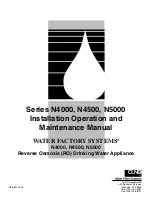
4
SAFETY AND ACCIDENT PREVENTION INFORMATION
When working near the pump, dress appropriately, avoiding clothes with loose items (ties, scarves, etc.) which could get caught in moving
parts. Use overalls made according to safety regulations, gloves, insulating shoes, safety glasses, ear plugs and helmet (fig.1).
Do not carry out maintenance on the motor while it is running.
Keep hands away from moving parts (e.g. belts, couplings, etc.).
Keep hands away from hot areas of the engines.
Do not mount on the pump to carry out maintenance operations of any kind.
5
IN CASE OF EMERGENCY
Shut down the motor.
Notify the person responsible for running the plant immediately.
6
HANDLING AND TRANSPORT
6.1 Method of transport
The pump must be transported in the horizontal position and stowed safely
During installation and maintenance, all the components used must be handled and
transported securely by using suitable slings. Handling must be carried out by spe-
cialised personnel to avoid damage to the pump and to persons. The lifting rings
attached to various components should be used exclusively to lift the components
for which they have been supplied.
Figure 2 highlights in black the lifting points of some typical base plates.
fig. 1
Maximum lifting speed: V
max
≤≤
0,5 m/s
5
fig. 2
7
INSTALLATION
7.1
The pumps are tested and the by-pass (if fitted) set with a liquid which also serves to protect the internal surfaces for 6 months from date
of shipment.
This liquid is a mixture of oil and passive neutral detergent; if this liquid could pollute the product to be pumped, it is necessary to wash
out the pump before installation. Do not pump water for any reason, or leave traces of water in the casing.
7.2
Install the pump as near as possible to the source of the liquid to be pumped leaving sufficient space for access for inspection and main-
tenance. In particular, space is required in front of the pump for removing the cover, near the gland for replacing the packing, near the oil
discharge plug of the gear box (if fitted) and on the terminal box side of the electric motor.
7.3
Identify the suction and discharge ports before installation. V series pumps are totally reversible: the direction of flow can be inverted by
changing the direction of rotation of the shaft. This means that the suction and disharge ports are not fixed at the outset but can be inter-
changed. If a by-pass relief valve is fitted, however, it operates only in one direction of flow (see paragraph 7.4).
Figure 3 shows the flow path of the liquid inside the
pump; as the gears open, liquid is drawn into the pump
and this area is therefore near the suction port. The liq-
uid is carried between the gears and the crescent and is
expelled from the disharge port as the gears mesh.
7.4
It is always advisable to mount a by-pass relief safety valve which can be supplied and mounted even after the pump has been installed.
If for any reason the discharge line should be blocked when the pump is operating, the pressure generated can reach very hig levels,
endangering the transmission or the pipework joints. The relief valve is mounted externally on the pump cover or casing and can be set
from outside.
fig.3


































